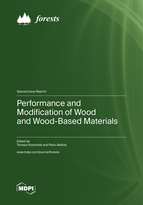Performance and Modification of Wood and Wood-Based Materials
A special issue of Forests (ISSN 1999-4907). This special issue belongs to the section "Wood Science and Forest Products".
Deadline for manuscript submissions: closed (25 November 2022) | Viewed by 36820
Special Issue Editors
Interests: wood technology; adhesives and lacquer products; wood based materials; wood modification; non-wooden materials; energy-saving sources of energy for curing and hardening of lacquer products and adhesives; economical and technological aspects of gluing and finishing technologies
Special Issues, Collections and Topics in MDPI journals
Interests: wood science and technology; wood–polymer composites; lignocellulosic based composites; wood modification; wood bonding
Special Issues, Collections and Topics in MDPI journals
Special Issue Information
Dear Colleagues,
Wood remains one of the most attractive construction materials. However, its applications are limited because it undergoes biological degradation, is combustible, and changes its properties under the influence of weathering conditions. Many of these disadvantages of solid wood are to some extent eliminated in wood-based materials such as plywood, particleboard, fiberboard, OSB, etc. However, in addition to the fact that it is not possible to completely eliminate the shortcomings of solid wood, these materials are bring new shortcomings, such as toxicity. Therefore, the problem of improving the properties of wood and wood-based materials is still in need of solutions. One of the effective ways to improve the properties of wood and wood-based materials is to modify them by conventional (thermal, chemical etc.) or the latest (plasma treatment) processes. With regard to wood-based materials, it is possible to treat their components (particles, fibers, glue, etc.) and the use them in wood-based materials or to use the post-treatment of ready-made materials to improve their certain properties.
Emphasis in this Special Issue is placed on updating and expanding the knowledge concerning conventional and novel modification processes of wood and wood-based materials, their improved/modified properties, and their relevant applications.
Dr. Tomasz Krystofiak
Prof. Dr. Pavlo Bekhta
Guest Editors
Manuscript Submission Information
Manuscripts should be submitted online at www.mdpi.com by registering and logging in to this website. Once you are registered, click here to go to the submission form. Manuscripts can be submitted until the deadline. All submissions that pass pre-check are peer-reviewed. Accepted papers will be published continuously in the journal (as soon as accepted) and will be listed together on the special issue website. Research articles, review articles as well as short communications are invited. For planned papers, a title and short abstract (about 100 words) can be sent to the Editorial Office for announcement on this website.
Submitted manuscripts should not have been published previously, nor be under consideration for publication elsewhere (except conference proceedings papers). All manuscripts are thoroughly refereed through a single-blind peer-review process. A guide for authors and other relevant information for submission of manuscripts is available on the Instructions for Authors page. Forests is an international peer-reviewed open access monthly journal published by MDPI.
Please visit the Instructions for Authors page before submitting a manuscript. The Article Processing Charge (APC) for publication in this open access journal is 2600 CHF (Swiss Francs). Submitted papers should be well formatted and use good English. Authors may use MDPI's English editing service prior to publication or during author revisions.
Keywords
- wood modification processes
- chemical treatment of wood
- hydrothermal treatment of wood
- thermo-hydro and thermo-hydro-mechanical treatment of wood
- thermal and thermo-mechanical treatment of wood
- acetylation of wood
- surface densification
- surface treatment of wood and wood-based materials
- plasma surface treatment
- properties of modified wood
- properties of modified wood-based materials
- wettability of wood and wood-based materials and their treated surfaces
- surface properties of wood and wood-based materials
- aesthetic properties of wood and wood-based materials
- fire-retardant additives
- water-repellent additives







